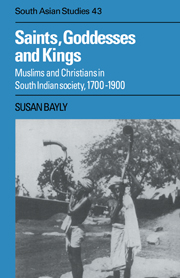Book contents
- Frontmatter
- Contents
- List of plates
- List of maps
- Preface
- Note on transliteration
- List of abbreviations
- Introduction
- Part I
- 1 South Indian religion and society
- 2 The development of Muslim society in Tamilnad
- 3 The Muslim religious tradition in south India
- 4 The south Indian state and the creation of Muslim community
- 5 Warrior martyr pirs in the eighteenth century
- 6 The final period of nawabi rule in the Carnatic
- Part II
- Select glossary
- Bibliography
- Index
- CAMBRIDGE SOUTH ASIAN STUDIES
- Plate section
1 - South Indian religion and society
from Part I
Published online by Cambridge University Press: 04 December 2009
- Frontmatter
- Contents
- List of plates
- List of maps
- Preface
- Note on transliteration
- List of abbreviations
- Introduction
- Part I
- 1 South Indian religion and society
- 2 The development of Muslim society in Tamilnad
- 3 The Muslim religious tradition in south India
- 4 The south Indian state and the creation of Muslim community
- 5 Warrior martyr pirs in the eighteenth century
- 6 The final period of nawabi rule in the Carnatic
- Part II
- Select glossary
- Bibliography
- Index
- CAMBRIDGE SOUTH ASIAN STUDIES
- Plate section
Summary
Introduction
This chapter is intended as a broad introduction to the religion, society and pre-colonial political traditions of south India. It concentrates on those features of the region's culture and social organisation which bear directly on the main themes of the book; its aim is to provide essential background information for the discussion of south India's indigenous ‘convert’ communities.
South India is a land of two contrasting natural environments. For at least 1,500 years intensive rice cultivation has been practised in the fertile river valleys and deltas of the Tamil country and along the lush maritime strip of the Malabar coast (now known as Kerala). Through the development of sophisticated water management techniques, these paddy-growing areas became the ‘core zones’ of a rich agricultural and trading economy with strong links with the maritime entrepots of west Asia and the far east. By the tenth-century AD five powerful kingdoms had been founded in the most productive of these areas, that is in the territories known as the ‘wet south’. Their rulers belonged to powerful land-controlling groups who gradually formed into loosely organised caste groupings or status categories such as the Vellalas of Tamilnad and the arms-bearing Nayars of the Malabar coast.
Most of the people who claimed the right to use these titles had adopted new gods and hierarchical social conventions from priestly Brahman groups who had been settling in these favoured agricultural regions from before the first century AD.
- Type
- Chapter
- Information
- Saints, Goddesses and KingsMuslims and Christians in South Indian Society, 1700–1900, pp. 19 - 70Publisher: Cambridge University PressPrint publication year: 1990



